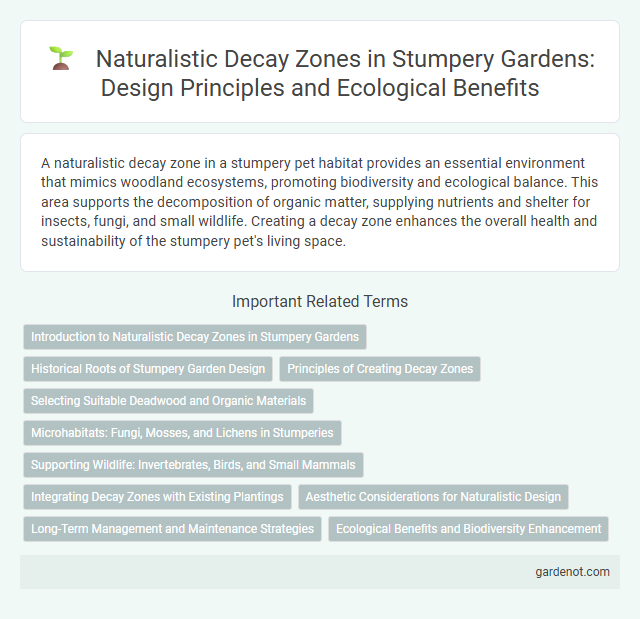A naturalistic decay zone in a stumpery pet habitat provides an essential environment that mimics woodland ecosystems, promoting biodiversity and ecological balance. This area supports the decomposition of organic matter, supplying nutrients and shelter for insects, fungi, and small wildlife. Creating a decay zone enhances the overall health and sustainability of the stumpery pet's living space.
Introduction to Naturalistic Decay Zones in Stumpery Gardens
Naturalistic decay zones in stumpery gardens mimic the natural process of wood decomposition, promoting biodiversity by providing habitats for fungi, insects, and microorganisms. These zones enhance soil fertility through nutrient recycling while supporting woodland ecology within garden spaces. Incorporating diverse decaying wood types and varying moisture levels optimizes the ecological benefits and aesthetic appeal of stumperies.
Historical Roots of Stumpery Garden Design
Stumperies originated in 19th-century England as garden features that creatively repurposed tree stumps and roots, embracing naturalistic decay to showcase woodland textures and promote biodiversity. These designs reflect a Victorian fascination with nature's organic forms, blending art and ecology by allowing decomposing wood to serve as habitats for fungi, mosses, and invertebrates. Stumperies capture a historical appreciation for the aesthetic and ecological value of natural decay zones within garden landscapes.
Principles of Creating Decay Zones
Creating effective naturalistic decay zones involves layering diverse organic materials such as logs, leaves, and bark to mimic forest floor processes. Prioritizing habitat complexity supports fungi, invertebrates, and microfauna essential for nutrient cycling and ecosystem health. Positioning decay zones in shaded, moist areas enhances decomposition rates and promotes biodiversity within stumpery gardens.
Selecting Suitable Deadwood and Organic Materials
Selecting suitable deadwood for a naturalistic decay zone involves choosing diverse types of wood such as oak, beech, and sycamore that support various fungi and invertebrate species. Incorporating organic materials like leaf litter, bark, and moss enhances habitat complexity and nutrient cycling, creating optimal conditions for decomposers. Prioritizing locally sourced, untreated wood ensures ecological compatibility and promotes biodiversity within the stumpery ecosystem.
Microhabitats: Fungi, Mosses, and Lichens in Stumperies
Stumperies create ideal microhabitats for diverse fungi, mosses, and lichens by providing a naturalistic decay zone where moisture and organic matter accumulate. The rotting wood supports saprophytic fungi that decompose organic material, while mosses thrive in the shaded, damp environment, stabilizing humidity levels. Lichens colonize the rough bark surfaces, contributing to ecosystem biodiversity and signaling air quality within these specialized garden features.
Supporting Wildlife: Invertebrates, Birds, and Small Mammals
A naturalistic decay zone in a stumpery provides essential habitats for invertebrates such as beetles, woodlice, and spiders, which contribute to nutrient cycling and soil health. This environment attracts birds like woodpeckers and robins that forage for insects while offering nesting sites, supporting avian biodiversity. Small mammals, including hedgehogs and shrews, utilize the decaying wood for shelter and foraging grounds, promoting a balanced ecosystem within the garden.
Integrating Decay Zones with Existing Plantings
Integrating naturalistic decay zones within existing plantings enhances biodiversity by providing essential habitats for fungi, insects, and detritivores that accelerate nutrient cycling. Positioning stumperies in shaded areas with rich soil moisture promotes decomposer activity, supporting plant health through improved soil structure and fertility. This synergy between decay zones and living plants fosters a resilient ecosystem, encouraging natural regeneration and ecological balance.
Aesthetic Considerations for Naturalistic Design
In naturalistic decay zones within a stumpery, aesthetic considerations prioritize the organic integration of decomposing wood and native plants to create visually dynamic, texturally rich landscapes. Emphasizing mosses, lichens, and fungi enhances biodiversity while fostering a sense of natural transformation that appeals to woodland garden enthusiasts. The irregular shapes and weathered surfaces of stumps contribute to a harmonious, rustic aesthetic that celebrates ecological processes and seasonal changes.
Long-Term Management and Maintenance Strategies
Long-term management of a stumpery's naturalistic decay zone requires regular monitoring of moisture levels and structural integrity to promote habitat diversity and fungal colonization. Strategic placement of logs and stumps enhances microhabitats, encouraging the decomposition process and supporting invertebrate populations essential for nutrient cycling. Periodic removal of invasive species and minimal disturbance ensure sustained ecological balance, facilitating continuous natural decay and biodiversity.
Ecological Benefits and Biodiversity Enhancement
Stumperies create a naturalistic decay zone that supports diverse fungi, invertebrates, and microorganisms essential for nutrient cycling and soil health. This habitat fosters increased biodiversity by providing shelter and food resources for woodland creatures, including beetles, amphibians, and small mammals. The ecological benefits extend to improved soil structure and enhanced decomposition processes, promoting a balanced and resilient ecosystem.
Naturalistic decay zone Infographic

 gardenot.com
gardenot.com